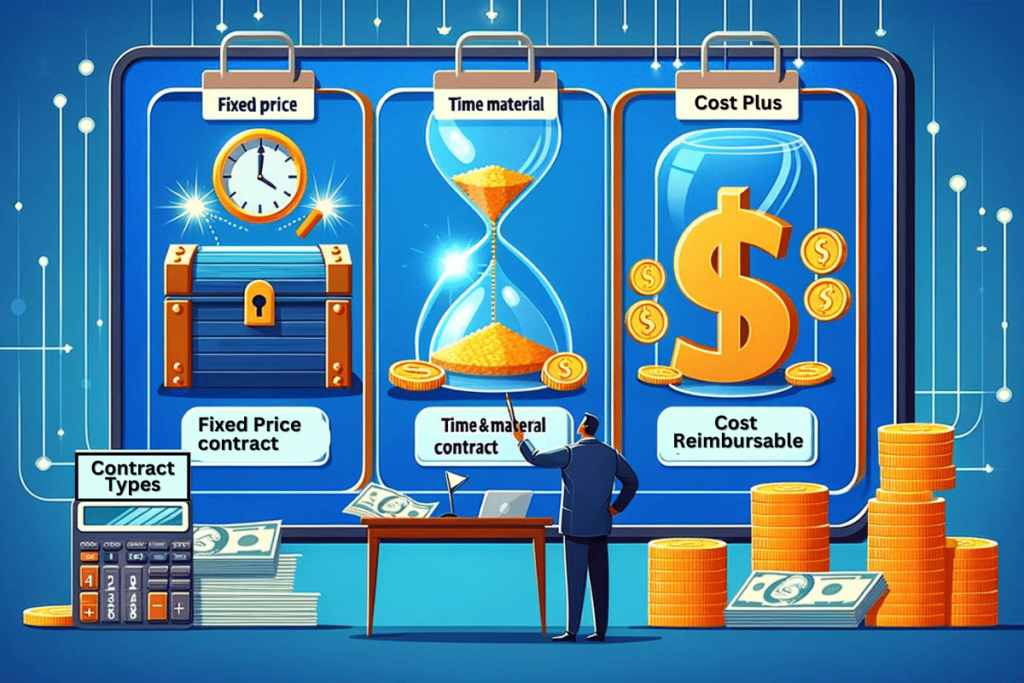Exploring the Various Types of Contracts in Project Management
Are you feeling lost in the world of project contracts? Here’s an interesting fact: there are mainly three types of contracts in project management that are used in managing projects – Fixed Price, Time and Material, Cost Reimbursable.
This blog will guide you through each one, helping you pick the right contract type for your projects. Get ready for clarity—read on!
Key Takeaways
- Fixed price contracts are great when project details are clear. They set a single cost, making budget control easier but putting risk on the seller.
- Time and material contracts offer flexibility for projects with changing scopes. Clients pay for actual work done, which requires close tracking of hours and expenses.
- Cost reimbursable agreements cover all expenses plus a fee for profit, suitable for uncertain projects. They need careful management to keep spending under control.
- Choosing the right type of contract depends on project scope, budget considerations, and risk levels. Making the correct choice can help manage timelines and avoid unexpected costs.
- Training in project management helps professionals understand these contracts better. It prepares them for real-world scenarios where picking the right agreement is crucial for success.
An Introduction to Project Contracts: 3 Main Types of Contracts in Project Management

Understanding project contracts marks a crucial step for project management and procurement professionals. These legal agreements set the stage, detailing what each party promises to do or deliver.
They cover everything from deadlines, costs, to how changes get managed. Mastering this area reduces risk and ensures projects finish on time.
Project management involves many choices, including selecting the right type of contract. This makes budgeting easier but can be risky if unexpected challenges arise.
- Fixed-price contracts are straightforward – you agree on a price and that’s what the project costs, no matter what happens along the way. They require clear requirements upfront. The seller takes most of the risk because they must complete the job (defined scope of work) in the budget agreed.
- Time and material contracts are different. A buyer’s pays the seller for hours worked plus materials used. It’s like hiring someone by the hour—it gives flexibility but can lead to higher costs if not watched closely. This type is used if the scope of services is not clearly defined, but buyer bears the burden of the risk. It requires close monitoring to keep expenses in check.
- Cost reimbursable contracts cover actual expenses plus an additional fee for profit and fit projects with uncertain scope that might shift significantly. These agreements are useful and have different “flavors” that allow adjustments as work progresses.
Each contract type – fixed price, time and material, or cost reimbursable – has a unique fit depending on project scope, risk tolerance, and financial strategies within project management practices like Agile or Scrum frameworks.
Choosing wisely can mean smoother sailing for your projects in terms of managing timelines, budgets, and expectations
Read on: Diving Deeper: Insights Beyond the Basics

Understanding contracts goes beyond just knowing the types. It involves getting into details like what makes a contract legally binding and how different elements play a role. Think about how scope of work, project timeline, and payment terms fit together in a puzzle.
Also, consider how change management and risk management are crucial parts of this picture.
Training programs, like PMP® Certification Training Course or Post Graduate Program in Project Management from Simplilearn, teach these concepts in depth. They prepare you for real-world scenarios where understanding the finer points of contracts can make or break a project.
Knowing about these training opportunities helps project managers and procurement professionals stay ahead in their game.
3 Types of Contracts in Project Management: Exploring the Common Contract Types

Clear contracts set the stage for success in project management. They outline what needs to happen, who will do it, and how much it will cost. This clarity helps both sides know what to expect.
Think of a contract as a blueprint. It guides the project from start to finish.
Contracts come in different shapes – fixed price, time and material, and cost reimbursable are just a few types. Each type suits different projects and needs. Using the right one keeps things smooth and avoids surprises later on.
This is where understanding these options becomes key for project managers and procurement professionals alike.
Overview of Fixed Price Contracts
With Fixed Price Contracts, both the seller and buyer agree on a set price for the project. This type of agreement places a high level of risk on the seller. Such contracts are ideal when project details are clear and changes are unlikely.
Examples include agreements like Fixed Price Incentive Fee (FPIF), Fixed Price Award Fee (FPAF), and adjustments for economic changes in price (Fixed Price Economic Price Adjustment – FPEPA).
These contracts work best when there’s a strong focus on finishing within a preset budget.
Sellers prefer this contract when they understand all job requirements upfront. It gives them confidence to commit to a fixed cost without worrying about fluctuations that could affect profit margins.
For buyers, it means certainty in costs from start to finish, promoting better budget management and financial planning. Using tools like work breakdown structures helps both parties outline every detail, ensuring everyone agrees before any work begins.
Overview of Time and Material Contracts
Time and Material contracts stand out as a go-to choice for projects where the full scope isn’t clear from the start. In these agreements, clients pay for the amount of work done plus the materials used.
It’s like hiring someone to paint your house without knowing how many coats it will need—you agree to cover their time and whatever paint they use. This setup gives both parties flexibility.
The client doesn’t overpay if less effort is needed, and workers are sure to be paid fairly for every hour spent.
This type of contract puts trust in the transparency between everyone involved. Keeping track of hours worked and resources bought becomes crucial here. Using project management tools can help keep this easy and honest, ensuring no doubts about costs arise.
Moving on, let’s explore Cost Reimbursable Contracts next—they’re another key piece in managing projects with care and precision.
Overview of Cost Reimbursable Contracts
Cost Reimbursable Contracts come into play when project details are blurry. In these agreements, the buyer covers all expenses plus a little extra for the seller’s effort. This type of contract steps in when projects have many unknowns or are highly unpredictable.
It’s like betting on a horse race without knowing the horses – risky but sometimes necessary. These contracts shine during complex jobs where you can’t pin down every detail at the start.
They’re especially useful for abstract tasks that evolve over time, such as innovative projects or research and development efforts. Imagine planning a big event without knowing how many guests will show up – this is where Cost Reimbursable Contracts save the day by covering fluctuating costs.
With options like Cost Plus Fixed Fee (CPFF) and Cost Plus Award Fee (CPAF), they offer flexibility in managing expenses while aiming to keep budgets in check. Now, let’s shift our focus to variations of cost reimbursable contracts to see how they further fine-tune this flexibility.
Pros and Cons: Situations for Use
After exploring the details of Cost Reimbursable Contracts, it’s time to shift our focus. Let’s look at the downsides and best settings for using different contract types in project management.
- Fixed Price Contracts bring a lot of risk to the seller. These contracts work well when the project’s scope is clear from the start. Yet, if things change or unexpected challenges pop up, sellers might have to cover extra costs.
- Time and Material Contracts offer flexibility but can lead to higher expenses for the buyer. They fit best in projects where it’s hard to estimate tasks and time needed upfront. Monitoring expenses closely is key here.
- Cost Reimbursable Contracts place most of the risk on the buyer since they agree to pay all project costs plus additional fees. These contracts are a match for projects with uncertain scopes or ones that carry high risks.
Each type of contract has its setting where it shines, along with potential pitfalls that professionals should weigh carefully before deciding which path to take for their project’s success.
Analysis of Fixed Price Contracts

Moving from understanding the drawbacks and suitable scenarios for various contracts, we delve into fixed price agreements. These contracts set a solid groundwork between buyers and sellers by locking in a set fee.
Sellers take on more risk because they agree to deliver work at this agreed-upon price no matter what happens during the project’s life cycle. This type of arrangement demands precise scope definition and clear expectations from both parties.
Fixed price projects often lead to better budget control for the buyer since costs are predictable from the start. However, if changes arise or something unexpected occurs, adjusting can be tricky without renegotiating terms – which might not always be possible or could lead to additional charges.
Examples include Fixed Price Incentive Fee (FPIF) deals, where sellers may earn extra if they meet certain performance metrics, showing that these arrangements can also incentivize high-quality work within budget constraints.
Benefits and Drawbacks – Fixed Price Contracts
Fixed price contracts, also known as lump sum agreements, offer a clear budget for project work. This type of contract makes the seller take on most of the risk.
Benefits:
- Easy to Budget: With a fixed price, companies know exactly how much they will spend. This makes it simpler to plan finances without worrying about going over budget.
- Motivation for Efficiency: Sellers have a strong reason to work efficiently. If they finish under budget, they keep the extra money. This often leads to projects being completed faster and more effectively.
- Less Supervision Needed: Buyers don’t have to watch every step of the process closely. Since the cost is set in stone, there’s no need to monitor spending tightly.
- Simplicity in Contracts: These agreements are straightforward. Both parties agree on a price, and that’s that. There’s no need for complicated cost analyses or adjustments.
Drawbacks:
- High Initial Prices: Sellers often set higher prices to cover themselves against unexpected costs. This means buyers might pay more than with other contract types.
- Limited Flexibility: Changes in the project scope can lead to disputes or require renegotiation of the contract price, which can be time-consuming and costly.
- Risk of Quality Cutting: To stay within budget, sellers might opt for cheaper materials or shortcuts that compromise quality.
- Potential for Disputes: If there are disagreements about the scope or specifics of the provided work, resolving these disputes can slow down the project and add costs.
Fixed price contracts shine when projects have clear definitions and end goals from the start.
Examples of Use – Fixed Price Contracts
Fixed price contracts are popular in project management. They work well when we know exactly what needs doing.
- Building a New Office: A company wants a new headquarters. They hire a construction firm to build it for a set price. This keeps costs predictable.
- Launching a Marketing Campaign: A business plans to introduce a new product. They contract a marketing agency for a fixed amount to handle the advertising, ensuring budget control.
- Developing Software: An app development project with clear requirements uses a fixed price model. The client pays a lump sum for the finished software, avoiding extra costs.
- Manufacturing Products: When ordering large quantities of goods, companies often use fixed price deals. It guarantees the cost per unit stays the same, making financial planning easier.
- Organizing Events: Planning big events like conferences involves many moving parts—venue, catering, speakers. Using fixed price agreements helps lock in prices for these services beforehand.
Each example demonstrates how fixed price contracts help manage expenses and clarify expectations from the start of a project to its completion in various fields like construction, marketing, software development, manufacturing, and event planning.
Analysis of Time and Material Contracts
Shifting focus from the fixed price contracts, we now delve into Time and Material (T&M) Contracts. T&M agreements shine when project scopes are not clear from the start. They allow flexibility for both parties involved – the buyer and service provider.
In these contracts, clients pay for all labor hours at set rates plus the cost of materials used in the project. This setup is ideal for projects where requirements might change or evolve over time.
Time and Material Contracts bring specific benefits like adaptability to changing conditions and direct transparency in billing. Yet, they also carry risks such as potential budget overruns if not closely monitored.
Successful management of T&M contracts requires solid procurement strategies that align with organizational policies, ensuring costs remain under control while achieving project objectives.
These agreements often necessitate keen oversight through tools like work logs and expenditure reports to track progress against budgets accurately.
Benefits and Drawbacks – Time and Material Contracts
Time and Material contracts offer flexibility and control within project management and procurement fields. These agreements allow for adjustments as the project evolves, but they also require careful oversight.
Benefits:
- Flexibility in Scope – Projects can adapt to changes without renegotiating the entire agreement.
- Pay for Actual Work – Only the actual hours worked and materials used are billed, promoting fairness.
- Easier to Start – Less need for detailed specifications up front makes these agreements quicker to initiate.
- Stronger Project Manager Control – Offers project leaders a closer grip on both budget and timeline through direct engagement.
Drawbacks:
- Risk of Budget Overrun – Without a cap, costs can spiral if not monitored closely.
- Requires Detailed Tracking – Project managers must meticulously document hours and expenses, demanding more administrative work.
- Uncertain Total Cost – The final price is not set in stone, which can challenge budget forecasts.
- Potential for Reduced Efficiency – Contractors might lack motivation to work efficiently since payment is by hour or material used.
In summary, Time and Material contracts suit projects where scope is uncertain or likely to change. They provide flexibility but demand rigorous oversight from project teams to ensure success without overspending.
Examples of Use – Time and Material Contracts
Time and Material contracts are great for projects where the scope is not fully known. They allow flexibility and ensure that workers get paid for all their work hours. Here’s how different industries use them:
- Software Development Projects: Often, creating new software or apps involves unexpected tasks. A Time and Material contract lets developers charge for every hour they code, test, or fix bugs. This setup helps when new features get added mid-project.
- Consulting Services: Experts in fields like finance or marketing offer advice over time. These contracts ensure consultants get paid for meetings, research, and report-making time. It’s ideal because some projects require more investigation than initially thought.
- Construction Work: Building or renovating spaces can have unpredictable challenges like weather delays or discovering the need for extra work on foundations. Workers log hours spent on manual labor, designing plans, and overseeing construction sites to ensure fair payment.
- Creative Projects: Designers and writers often use Time and Material contracts when crafting ads, branding materials, or websites since creativity doesn’t fit neatly into a fixed schedule or price. As ideas evolve, these professionals track their time spent creating drafts and revisions.
- Event Planning: Organizing events involves many moving parts—venue booking, vendor negotiation, and program scheduling—each taking an unknown amount of time. Planners use these contracts to account for every hour spent making calls, sending emails, and meeting with clients.
- IT Support Services: Tech support teams handle varied issues daily—from simple password resets to complex system outages—that make it hard to predict workload accurately. They log time spent troubleshooting to ensure each client’s needs are met while providing flexible billing based on actual work done.
- Legal Services: Lawyers often deal with cases that can take more (or less) time than you might expect due to negotiations outside of courtrooms needing unplanned research or document preparation times.
In each case above, Time and Material contracts offer a way to manage tasks flexibly while ensuring everyone gets paid for their hard work regardless of project uncertainties.
Analysis of Cost Reimbursable Contracts

Cost Reimbursable Contracts let companies pay for all the legitimate expenses plus a fee that covers profit. This kind of contract is great for projects where it’s hard to predict costs from the start.
The Project Management Institute suggests this type of agreement for projects needing flexibility and those where spending could change. It puts project managers in a vital role, ensuring they manage costs effectively throughout the project’s life.
These contracts require detailed oversight and management by project managers to keep everything on track financially. They often choose Cost Plus Fixed Fee or Cost Plus Incentive Fee agreements among others, aiming at motivating service providers while controlling expenses.
Assessing risks becomes crucial before agreeing to such contracts, as does staying involved in every purchase decision during the project. This careful attention helps secure a successful outcome and keeps the budget under control despite unpredictability.
Benefits and Drawbacks – Cost Reimbursable Contracts
After exploring the essence and mechanics of cost reimbursable contracts, let’s dive deeper into their benefits and drawbacks. This will help you grasp when these contracts are most effective and the challenges they might pose.
Benefits:
- Flexibility: These agreements allow flexibility in project scope, making them ideal for tasks where details aren’t clear from the start.
- Risk Distribution: The buyer bears most risks associated with cost overruns, providing a safety net to sellers against unforeseen expenses.
- Improved Contractor Focus: Since reimbursement is guaranteed, contractors may focus more on quality rather than cutting corners to stay within a fixed budget.
- Transparency: They mandate detailed record-keeping and reporting of expenses, leading to transparency between parties involved.
Drawbacks:
- Unlimited Costs: A significant downside is that expenses can spiral without a cap, leaving buyers exposed to potentially high costs.
- Management Intensive: These types of agreements require close monitoring and administration to keep track of actual expenditures versus projected ones.
- Potential for Misuse: Sellers might not have strong incentives to control costs, given that all legitimate expenses are reimbursed by the buyer.
- Requires Trust: Such contracts demand a high level of trust between the contracting parties due to potential financial abuses.
This insight into cost reimbursable contracts shows they offer flexibility and risk management for complex projects but also come with challenges in cost control and management effort required.
Examples of Use – Cost Reimbursable Contracts
Cost-reimbursable contracts play a big role in the project management field. They help when projects have uncertain elements that need flexibility. Here’s how they often get used:
- Large Construction Projects: These projects can face unexpected issues, like weather delays or material shortages. A cost-reimbursable contract allows for these changes without huge extra costs. The builder gets paid for actual work done, plus a fee.
- Research and Development (R&D) Projects: In R&D, outcomes are unpredictable. Companies prefer cost-reimbursable contracts here because they can adjust the scope as new information surfaces. This ensures innovation isn’t stifled by strict budget limits.
- Government Contracts: Many government projects involve complex, evolving requirements that a fixed-price contract can’t easily handle. With a cost-reimbursable contract, agencies can adapt to changes without renegotiating the terms of the agreement.
- Tech and Software Development: Like R&D, developing new technology or software can face lots of unknowns. Teams might discover better solutions halfway through the project requiring more resources than initially planned.
- Event Planning and Management: Big events often encounter last-minute changes – from guest numbers to venue issues. A cost-reimbursable contract gives event planners the leeway to deal with surprises while still keeping the project on track.
Each example shows how important it is for both parties to agree on clear terms and keep detailed records of expenses and progress.
Variations of Cost Reimbursable Contracts

Lets dive into the different forms of cost reimbursable contracts. These vary mainly in how they handle fees and incentives. The Cost Plus Fee (CPF) or Cost Plus Percentage of Costs (CPPC) contract adds a percentage on top of the actual expenses.
This means if costs go up, so does the seller’s profit. On the other hand, a Cost Plus Fixed Fee (CPFF) agreement gives the seller a set fee regardless of total costs.
The Cost Plus Incentive Fee (CPIF) motivates sellers to keep expenses low by offering them a bonus for saving money. Finally, with Cost Plus Award Fee (CPAF), fees are based on meeting specific performance goals rather than just saving cash.
Each type has its place depending on project needs and risks involved – making understanding them critical for effective contract management in project-based work.
Cost Plus Fee (CPF) or Cost Plus Percentage of Costs (CPPC)
Cost Plus Fee (CPF) or Cost Plus Percentage of Costs (CPPC) contracts help complete a project by paying for all project costs plus an extra amount as a fee. This type of contract is good when the scope isn’t clear from the start.
Think about using this contract if you expect changes during the project. It gives flexibility but needs careful tracking of expenses to make sure they stay reasonable.
Project managers like CPF or CPPC because it makes dealing with unexpected issues easier. They don’t have to renegotiate prices every time something changes, which saves time and keeps projects moving smoothly.
Just make sure there’s a system in place to track all spending and check it against what was planned.
Next, let’s look at Cost Plus Fixed Fee (CPFF).
Cost Plus Fixed Fee (CPFF)
In a Cost Plus Fixed Fee (CPFF) contract, the seller gets paid for all project costs plus a fixed amount as their fee. This setup works great for projects where things are not clear from the start.
Since the project’s requirements might change, this type of agreement allows flexibility. The buyer covers the actual expenses and pays an extra fixed charge on top.
Choosing CPFF contracts means project managers have to watch spending closely to prevent going over budget. They must understand every part of the work deeply. This careful management stops costs from ballooning beyond what was planned.
For projects filled with unknowns and uncertainties, CPFF agreements offer a way to move forward while keeping risks in check.
Cost Plus Incentive Fee (CPIF)
Cost Plus Incentive Fee (CPIF) is a type of deal where the seller gets paid for all project expenses plus an extra reward. This extra reward depends on how well they meet or beat the project’s goals.
It motivates the seller to aim higher and work smarter, ensuring that both time and money are well spent.
This contract ties rewards directly to performance metrics, pushing sellers towards excellence in managing tasks and resources efficiently. With CPIF, everyone involved wants to see the project succeed, as better performance leads directly to better payoffs.
Cost Plus Award Fee (CPAF)
Shifting from the CPAF model, we see a unique approach to project management contracts. Like its cousin, the CPIF contract, CPAF also aims to cover actual expenses plus an additional sum for the contractor.
But here’s the twist—the extra payment is not a simple incentive for meeting targets. Instead, it’s an award fee that hinges on subjective evaluation criteria set by the buyer.
This setup turns the table in favor of quality and precision over mere numbers. The seller earns their bonus based on performance reviews rather than hitting specific metrics alone.
Think of it as encouraging contractors to go above and beyond, ensuring projects aren’t just completed but are done with exceptional care and attention to detail.
Other Types of Contracts in Project Management
Moving from cost plus award fee agreements, let’s explore other significant contract forms in project management. Incentive fee contracts motivate the seller to exceed performance goals.
These reward systems can boost productivity and ensure projects meet higher standards. Another form, lump sum contracts, involve a single fixed price for all work, making them ideal for projects with well-defined scopes and deliverables.
Some contracts mix elements from various types to suit specific project needs better. A hybrid known as “time and materials not to exceed” sets a cap on the total expenses or duration of the contract, combining flexibility with financial control.
Each type plays a crucial role in managing risks and aligning interests between parties involved in completing a project successfully.
The Strategic Importance of Contracts in Project Management
Contracts play a vital role in project management. They set clear expectations and outline responsibilities for both parties involved. Think of contracts as the rule book for your project, making sure everyone knows what they are supposed to do.
This helps avoid misunderstandings and keeps the project on track.
Having a solid contract also provides legal protection. If something goes wrong, the contract can help solve disputes between teams and clients. For projects that span different fields like Cyber Security or Cloud Computing, this is especially important.
A well-crafted agreement supports successful project completion by ensuring all sides are on the same page from start to finish.
FAQs
1. What are the main types of contracts in project management?
In project management, there are three primary types of contracts: fixed-price contracts, cost reimbursable contracts (CR), and time and materials (T&M) contracts. Each type is used based on the project’s scope and requirements.
2. Why are legally binding contracts important in managing projects?
Legally binding contracts ensure that both parties – the buyer and the contractor – agree to complete the project as planned. They outline the estimated costs, scope, and timelines, making sure everyone sticks to their part of the deal.
3. How do fixed-price contracts work?
Fixed-price contracts set a firm price for completing a project upfront. This includes variations like firm fixed-price (FFP), fixed price with incentive (FPIP), and fixed price with economic price adjustment (FP-EPA). These are great when you know exactly what needs to be done.
4. Can you explain what a T&M contract is used for?
Time & Materials (T&M) contracts pay for actual labor hours at a predefined rate plus expenses on materials spent working on the project. They’re flexible, perfect for when it’s hard to estimate how long or complex a job will be.
5. What’s unique about cost reimbursable contracts?
Cost Reimbursable Contracts cover actual costs plus an additional fee that could be a percentage of costs or an agreed-upon amount. Useful when projects have uncertain elements that can affect costs over time.
6. Are there any special considerations I should include in my contract for successful project completion?
Absolutely! Your contract should clearly state the scope of work, deliverables, timeline, payment schedule, and any temporary manpower needs – basically anything crucial to meeting your project goals efficiently.
Conclusion
Exploring different types of agreements in project management opens up a world of clarity and security for all involved. We learned about fixed price, time and material, and cost reimbursable deals.
Each has its own place depending on the task’s needs. Knowing when to use which can save time and money. As we look ahead, it’s clear these agreements will keep playing a key role in successful project completion.
They make sure everyone is on the same page, cutting down confusion and guiding projects to their goals smoothly.
If you liked this article, remember to subscribe to MiamiCloud.com. Connect. Learn. Innovate.






